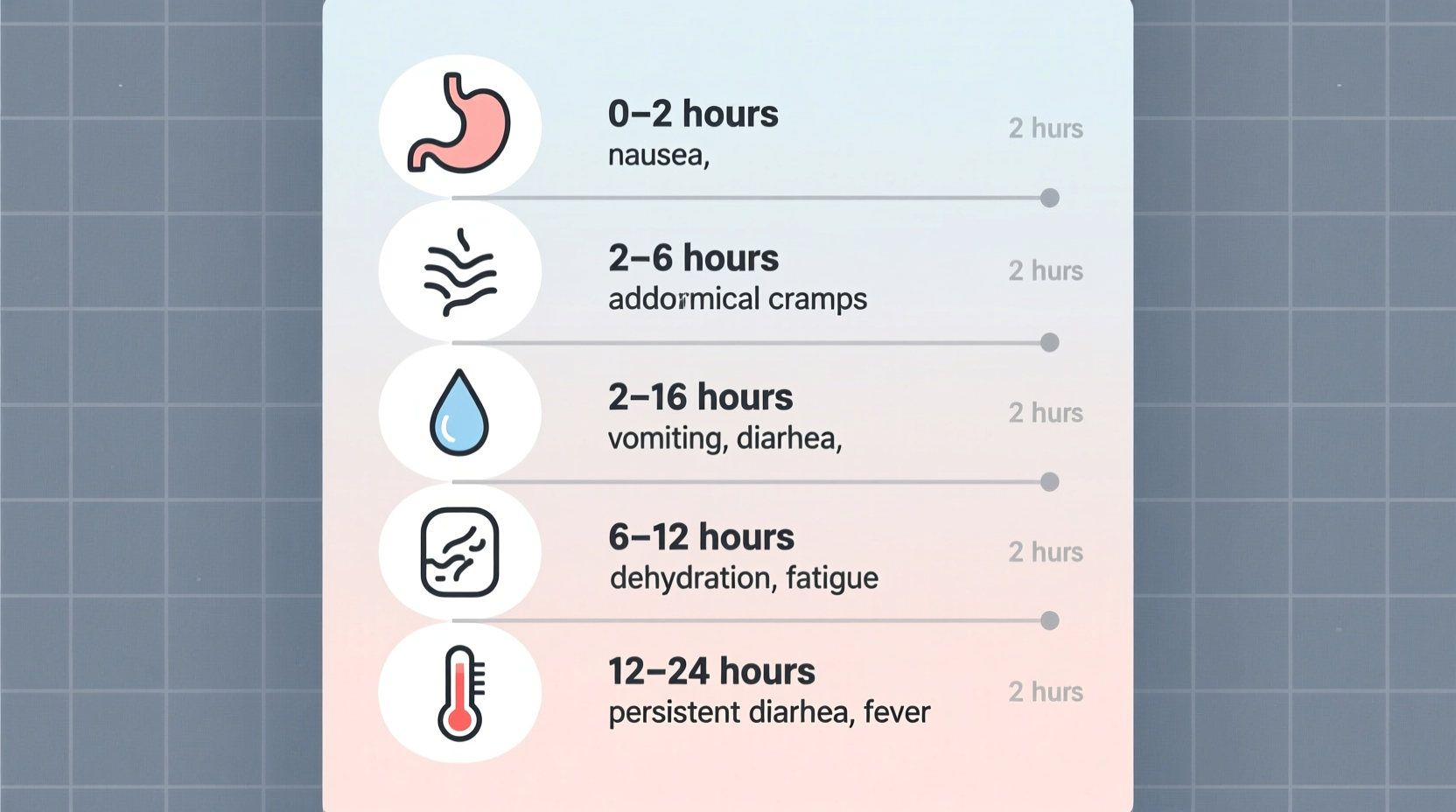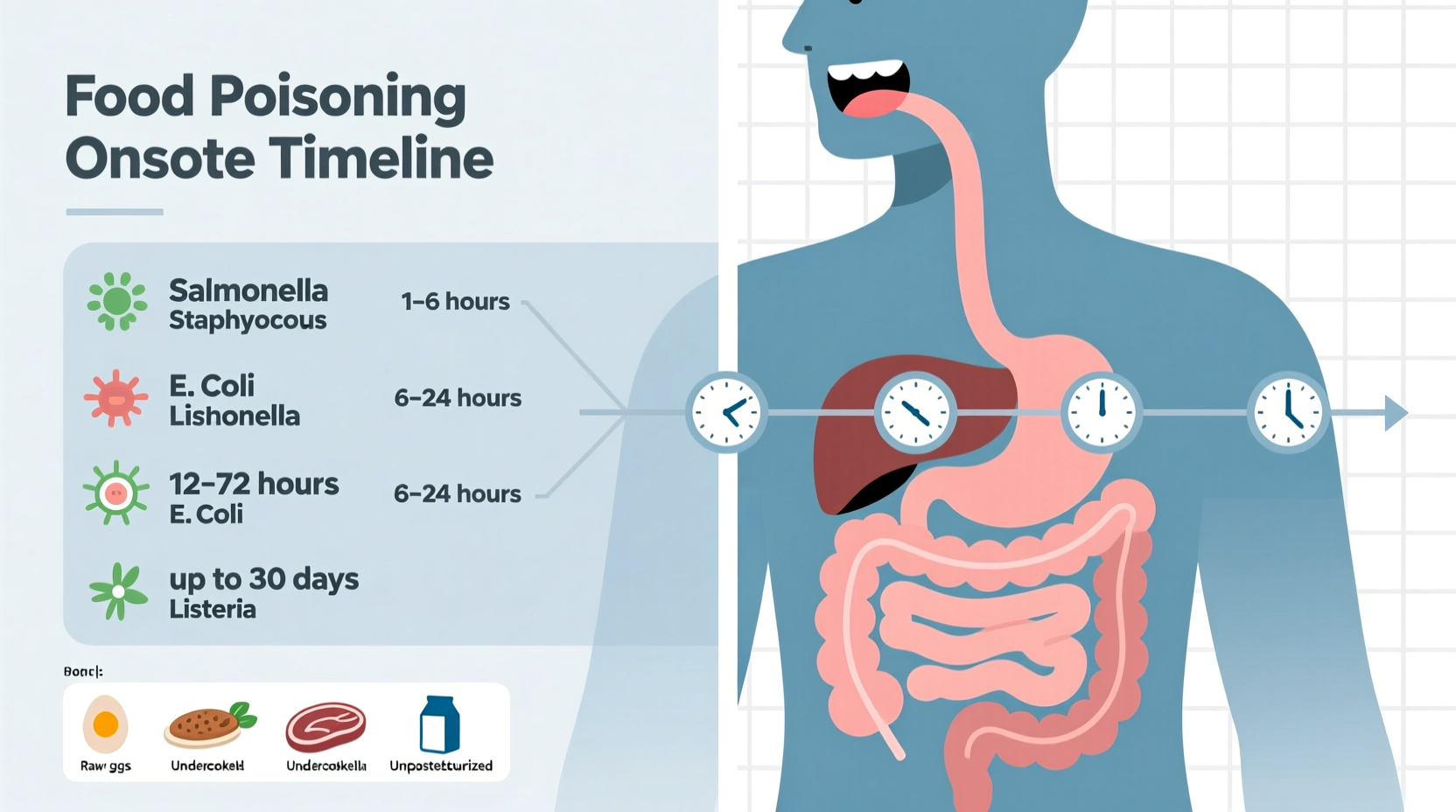Understanding how fast food poisoning occurs isn't just academic—it could be crucial for your health. When you're experiencing stomach discomfort after a meal, knowing the potential timeline helps determine whether it's food poisoning, when to seek medical attention, and how to prevent future incidents. This guide provides evidence-based information on food poisoning onset times from authoritative health sources.
Food Poisoning Timeframes: What You Need to Know Immediately
Most people assume food poisoning hits immediately, but the reality is more complex. The onset time depends entirely on what contaminated your food. While some pathogens trigger symptoms within hours, others take days or even weeks to manifest. Recognizing these patterns helps you identify potential sources and determine appropriate responses.
Pathogen-Specific Onset Times: Your Reference Guide
Different contaminants have distinct incubation periods. Here's what major health organizations report about how quickly symptoms appear for common foodborne illnesses:
| Pathogen/Toxin | Typical Onset Time | Common Sources | Duration |
|---|---|---|---|
| Staphylococcus aureus | 30 minutes - 8 hours | Handled foods, salads, dairy | 1-2 days |
| Bacillus cereus (vomiting type) | 30 minutes - 6 hours | Fried rice, leftovers | 6-24 hours |
| Norovirus | 12-48 hours | Contaminated water, shellfish | 1-3 days |
| Salmonella | 6 hours - 6 days | Raw eggs, poultry, produce | 4-7 days |
| E. coli (STEC) | 3-4 days | Undercooked beef, raw milk | 5-10 days |
| Listeria | 1-4 weeks | Delicatessen meats, soft cheeses | Variable |
| Clostridium botulinum | 12-36 hours | Home-canned foods, vacuum-packed | Weeks to months |
| Cyclospora | 1 week | Fresh produce, contaminated water | 2-12 weeks |
This comprehensive timeline comes from the Centers for Disease Control and Prevention's most recent foodborne illness surveillance data. Notice how dramatically onset times vary—this explains why pinpointing the exact source of contamination can be challenging without professional investigation.
Factors That Influence How Quickly Symptoms Appear
Several variables determine how fast food poisoning occurs after exposure:
Contaminant Type and Amount
Toxins like those produced by Staphylococcus aureus act fastest because they're pre-formed in food. In contrast, bacteria that need to multiply in your body (like Salmonella) take longer to cause symptoms. The quantity of contaminant matters too—larger doses often lead to quicker symptom onset.
Individual Health Factors
Your immune system strength significantly impacts onset time. The CDC reports that children, elderly individuals, and those with compromised immune systems often experience symptoms sooner and more severely than healthy adults. A 2023 study published in the Journal of Food Protection found that gastric acidity levels also affect how quickly pathogens establish infection.
Food Matrix Effects
The type of food consumed influences symptom timing. Fatty foods can delay stomach emptying, potentially slowing pathogen delivery to the intestines. Conversely, liquid foods move through the digestive system faster, possibly accelerating symptom onset.

When to Seek Immediate Medical Attention
While many food poisoning cases resolve without intervention, certain symptoms require prompt medical care. According to the FDA Food Code guidelines, seek emergency treatment if you experience:
- Symptoms beginning within 30 minutes of eating (possible chemical or toxin exposure)
- Blood in vomit or stool
- Signs of severe dehydration (dizziness, reduced urination, dry mouth)
- Fever above 101.5°F (38.6°C)
- Symptoms lasting more than 3 days without improvement
- Numbness, blurred vision, or muscle weakness (potential botulism)
Pregnant women, infants, and immunocompromised individuals should contact healthcare providers at the first sign of food poisoning symptoms, as they're at higher risk for complications.
Practical Prevention Strategies Based on Onset Times
Understanding how quickly food poisoning occurs informs smarter food safety practices:
High-Risk Short-Onset Foods
Foods that cause symptoms within hours (Staphylococcus, Bacillus cereus) typically involve improper temperature control. Always:
- Refrigerate cooked foods within 2 hours (1 hour if above 90°F/32°C)
- Avoid leaving salads, dairy products, or meats at room temperature
- Wash hands thoroughly before food preparation
Longer-Onset Pathogen Prevention
For pathogens with delayed symptoms (like Listeria), prevention requires different strategies:
- Thoroughly wash all produce under running water
- Cook meats to proper internal temperatures (use a food thermometer)
- Separate raw and cooked foods to prevent cross-contamination
- Be cautious with ready-to-eat foods if pregnant or immunocompromised
Documented Food Poisoning Outbreak Timelines
Real-world outbreak investigations provide valuable evidence about symptom onset patterns. During a 2022 multi-state outbreak linked to contaminated cantaloupes:
- First cases reported symptoms 24-72 hours after consumption
- Peak symptom onset occurred at 48 hours
- Investigators traced the source by analyzing symptom onset patterns across affected individuals
- The FDA's traceback investigation confirmed Salmonella contamination in the supply chain
This case demonstrates how understanding onset timing helps public health officials identify contamination sources during outbreaks.
When Symptoms Don't Match Expected Timelines
Occasionally, food poisoning symptoms appear outside typical windows. This might indicate:
- Multiple pathogens in the same food source
- Pre-existing gastrointestinal conditions
- Chemical contaminants not covered in standard foodborne illness tracking
- Non-food-related gastrointestinal illness
If your symptoms don't align with expected food poisoning timelines, consult a healthcare provider for proper diagnosis. The American College of Gastroenterology emphasizes that accurate diagnosis is essential for appropriate treatment.
Key Takeaways for Food Safety
Armed with knowledge about how fast food poisoning occurs, you can make smarter decisions about food handling and when to seek medical care. Remember these critical points:
- Symptom onset ranges from 30 minutes to 6 weeks depending on the contaminant
- Toxins cause the fastest symptoms; bacterial infections typically take longer
- Individual factors significantly influence onset time and symptom severity
- When in doubt about severe symptoms, seek medical attention immediately
- Proper food handling prevents most foodborne illnesses regardless of onset time











 浙公网安备
33010002000092号
浙公网安备
33010002000092号 浙B2-20120091-4
浙B2-20120091-4